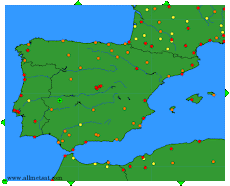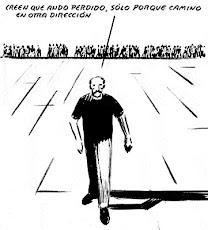La fiebre de la expansión aeroportuaria se ha trasladado de España a Alemania; eso sí, con alguna diferencia; así, mientras en España contaba con el beneplácito de casi todos, en Alemania la mayoría social parece no estar por la labor de convertir las zonas residenciales cercanas en infiernos inhabitables. ¡Ninguna capital de provincia sin aeropuerto ni estación del AVE! Era el eslogan suicida de unos políticos suicidas que convencieron a una sociedad suicida para financiar unos proyectos suicidas por unos bancos suicidas… hasta que llegó alguien y les dio una pistola. Los alemanes son muy cabales, conocen el riesgo al que se enfrentan y actúan preventivamente en la calle, con la movilización social, y en los juzgados, con demandas.
En Alemania, como en España, el diseño y ejecución de los planes de expansión aeroportuaria se llevan a cabo en el ámbito local y regional ¿Nos suena familiar? En ninguno de los dos países ha existido ni existe un debate nacional sobre esta cuestión.
Pero Alemania no es España y la sociedad civil germana no es la española, y los planes de expansión aeroportuaria de Frankfurt, Munich y Berlín se han topado con la oposición de los actuales y futuros afectados por la contaminación acústica.
En España primero se aplaude y se exigen inversiones y luego se lamentan las consecuencias, alguno protesta y decide ir a los juzgados, y si alguien osa ganar una sentencia entonces llega el gobierno y con el apoyo cómplice de la oposición cambia las leyes. En Alemania primero se quejan, se manifiestan y acuden a los juzgados y si ganan una sentencia se ejecuta y se respetan las leyes existentes. Así, en España, desde la aprobación de la reforma de la Ley de Navegación Aérea, es obligatorio soportar el ruido, bien porque reside en zona de servidumbre acústica en cuyo caso no puede hacer nada, bien porque su vivienda no está afectada legalmente y entonces se fastidia igualmente. En Alemania ya han conseguido el cierre nocturno del Aeropuerto de Frankfurt.
En España no hay una movilización nacional contra la locura aeroportuaria y sus consecuencias sobre la salud y la calidad de vida de los residentes en las zonas afectadas. No obstante, hay que reconocer y aplaudir el titánico esfuerzo que lleva a cabo la Asociación Nacional de Afectados por el Impacto del Tráfico Aéreo, ANAITA, en su lucha desigual contra AENA y la Dirección General de Aviación Civil del Ministerio de Fomento.
En Alemania, desde las primeras manifestaciones nacionales contra el ruido del pasado mes de octubre, hay una conciencia y un movimiento nacional emergente contra los planes de expansión aeroportuaria. Los números son contundentes: entre 10.000 y 20.000 personas se manifiestan regularmente en Frankfurt, entre 7.000 y 15.000 asisten a las manifestaciones contra el nuevo Aeropuerto de Berlín y 7.000 en Munich contra la construcción de una tercera pista.
Adjuntamos un artículo en el que se informa de las campañas y actuaciones que están llevando a cabo las asociaciones vecinales en defensa de su salud y calidad de vida con un lema claro: progreso sí pero no a cualquier precio.

Desde Las mentiras de Barajas animamos a los alemanes a continuar con las movilizaciones y la batalla judicial hasta que la razón alcance a los políticos y responsables de la locura aeroportuaria por las buenas, o los juzgados la impongan por el peso de la ley.

A new third runway at Munich airport?

The German Spring: Young Friends of the Earth Bavaria opposing airport expansion
Young Friends of the Earth Bavaria in Germany have been campaigning against the expansion of airports in Germany. Florian Sperk tells us about the campaign against a new third runway at Munich airport.
Written by Florien Sperk, Young Friends of the Earth Bavaria
Since the first nationwide anti-noise demonstrations took place last October in Frankfurt, rumours of an emerging national movement against airport expansion have grown. So what's up in Germany?
Over the last few years local protest groups around Germany's three main airports - Frankfurt, Berlin and Munich – have been growing. In Frankfurt about 10,000 to 20,000 people are demonstrating regularly. In Berlin 7,000 to 15,000 people have marched against the new airport. And in Munich up to 7,000 people have taken part in protests. But this spring something new happened.
Something big is coming up
This spring the different groups started noticing each other, and began to recognise the power they can have in working together. In Germany all aviation issues are planned and decided at a local and regional level by town halls, not at a national level. Thus there has been a lack of a national debate around aviation. Germany has never really asked itself key questions: about the value of the different airports to the economy, or whether there should be limits to growth, or what role a reduction in domestic flights could play in the national strategy to stop climate change. Many people are arguing that the time is now right to put the expansion of the aviation industry on the national agenda. And they could be right. The profits of Germany's main airline, Lufthansa, are tumbling. There may be no need for further expansion.
The third runway in Munich!
We now look at the current protest in Munich within the context of the bigger, national picture. In Munich the expansion of the airport is said to be needed to keep possible delays below 4 minutes over the next 20 to 30 years, assuming maximum usage of the airport. Some people might think this is a joke. But is not. It is actually the main justification given for the third runway. The authorities want to make sure maximum delay shall always be less than 4 minutes, even if the demand for flights doubles. The reality is, though, that the demand for flights is decreasing every month. So there is already evidence that the biggest climate-killer of Bavaria simply does not need to expand. The third runway in Munich can and will be stopped.
No third runway in Munich!
The main reasons Young Friends of the Earth Bavaria want to stop the third runway are explained in the following short movie, made by Young Friends of the Earth Bavaria.
But, for those how don't speak German, the reasons are:
1) The airport has debts of about 2.7 billion Euros.
2) The airport has made a profit only three times in its 20 year existence
3) The third runway will cost more than 1.2 billion Euros. And all this money will be spend for a saving of 4 minutes, at a time when the budgets for social projects are cut every year.
4) The airport is Bavaria's biggest climate-killer - with about 10 % of the total emissions of Bavaria.
5) More than 1000 hectares of a conservation area for birds will be destroyed.
6) One of the last big fens in Bavaria will be critically damaged.
7) About 40,000 to 80,000 people will suffer of noise and air-pollution
Munich can become Germany's Heathrow, the London activists say
Young Friends of the Earth Bavaria invited the successful activists of Plane Stupid and AirportWatch to Munich this spring. And guess what: John Stewart, one of the activists, told us that the current situation at Munich is very similar to the situation in London in the years before the third runway at Heathrow was finally stopped. And if the strategic mastermind of the Heathrow third runway campaign says something like this, it's up to us in Young Friends of the Earth to answer with massive campaigning.
Find out more about the movement against airport expansion in Germany















1 comentario:
En el último comentario que sobre este artículo hago en Aviación Digital he cometido un error involuntario, pero que como no consigo el que salga publicada la Nota aclaratoria, a continuación copio y pego aquí dicha Nota aclaratoria:
"
"Luis Guil Pijuan (14/0/2012)
Perdonen por el error cometido en mi anterior comentario.
Es obvio que si la función de DESPEGUE en ambos pares de pistas paralelas, 18R/18L y 33R/33L, AENA se las mantiene mutilada, y sin ESTRENAR en tres de las cuatro pistas (18R, 18L y 33R), los DESPEGUES EN BARAJAS SIEMPRE, SIEMPRE, SIEMPRE ...., SE EFECTUARAN CON EL VIENTO DE COLA Y SEA CUAL SEA SU INTENSIDAD, 10, 20 o 30 NUDOS, OBVIAMENTE AL TENERSE QUE EFECTUAR EN LOS DOS PARES DE PISTAS PARALES, 36L/36R y 15L/15R, a las que AENA en este caso lo que les mantiene mutilada y sin ESTRENAR en tres de ellas es la función de ATERRIZAJE, siempre evidentemente que la dirección del Viento sople entre 235º y 273º, que por otra parte son los despegues que habitualmente se efectúan en Barajas dado los vientos predominantes en la zona (léase orientación de las pistas de Torrejón, Getafe, C. Viento y las futuras 4 paralellas de Campo Real).
Por tanto es un error lo que figura en mi anterior comentario, en el que afirmo que en los despegues que se efectúen por el par de pistas paralelas "18R/18L" ....
El par de pistas paralelas correcta es 15R/15L.
Saludos "
Publicar un comentario